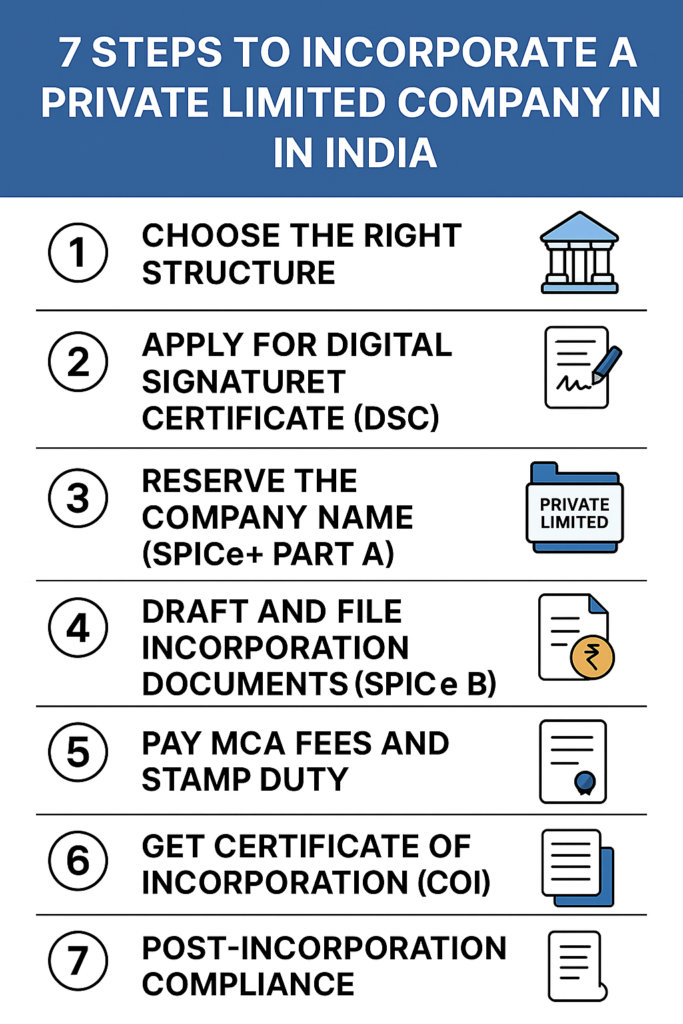Incorporating a Private Limited Company in India is one of the most popular and secure structures for startups, SMEs, and growing businesses. We often advise clients that registering a company is not just a legal requirement—it’s the first formal step in building a compliant, credible, and scalable business.
Whether you’re a first-time founder or an experienced entrepreneur, here’s a detailed yet simplified guide to help you navigate the incorporation process under the Companies Act, 2013.
A Private Limited Company is one of the most popular business structures in India. It provides limited liability, separate legal entity status, and better credibility.
Whether you’re a first-time founder or an experienced entrepreneur, here’s a detailed yet simplified guide to help you navigate the incorporation process under the Companies Act, 2013.
In this guide, you will learn step-by-step how to register your company.

Step 1: Choose the Right Structure
Before incorporation, ensure that a Private Limited Company is the right fit. It is ideal if:
- You want limited liability protection.
- You’re planning to raise equity funding.
- You want a separate legal identity from the owners.
- You have at least two directors and two shareholders
Step 2: Apply for Digital Signature Certificate (DSC)
All proposed directors must obtain a Digital Signature Certificate (DSC) from a licensed Certifying Authority. This is essential for signing documents electronically.
📌 Tip: Keep scanned copies of PAN, Aadhaar, Passport-size photo, and email & mobile ready.
Step 3: Reserve the Company Name (SPICe+ Part A)
Use the SPICe+ Part A form on the MCA portal to apply for name reservation. Ensure:
- The name is unique.
- Ends with “Private Limited”
- Doesn’t infringe on existing trademarks
💡 You can check name availability on MCA and also conduct a trademark search.
Step 4: Draft and File Incorporation Documents (SPICe+ Part B)
Once the name is approved, fill SPICe+ Part B with the following attachments:
- MOA (Memorandum of Association)
- AOA (Articles of Association)
- AGILE PRO (GST, EPFO, ESIC, bank account & professional tax registration)
- INC-9 (Declaration by subscribers)
- DIR-2 (Consent from directors)
- Utility bill & NOC from property owner (for registered office)
Step 5: Pay MCA Fees and Stamp Duty
The filing fee and stamp duty vary depending on the state and authorized capital. For most startups with ₹1 lakh authorized capital, total government charges are nominal.
Step 6: Certificate of Incorporation (COI)
If all documents are in order, MCA usually issues the Certificate of Incorporation (COI) within 3–5 working days. This includes:
- CIN (Corporate Identity Number)
- PAN and TAN (auto-generated)
- GSTIN if applied via AGILE PRO
Step 7: Post-Incorporation Compliance
After incorporation, ensure the following:
- Open a current bank account.
- Issue share certificates within 60 days.
- File Form INC-20A (Declaration of Commencement of Business).
- Appoint an auditor within 30 days.
- Start bookkeeping and annual compliance tracking.
- Open a current bank account.
Final Thoughts from ANK Legal Sahara.
Incorporation is the foundation—compliance is the key to sustainability. A well-structured private limited company not only builds trust but also makes due diligence, fundraising, and governance seamless.
At A&K Legal Sahara, we guide you from incorporation to full compliance, allowing you to focus on growing your business while we manage the legal and regulatory landscape.

